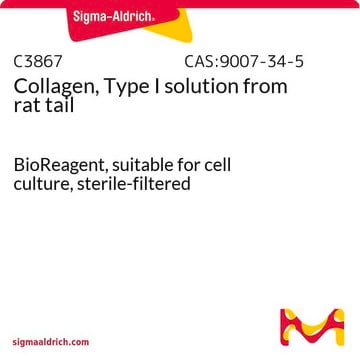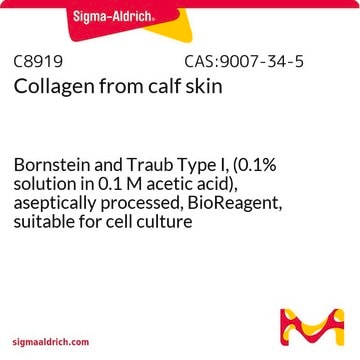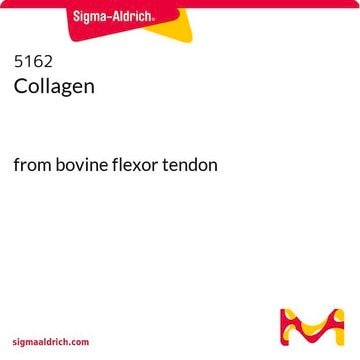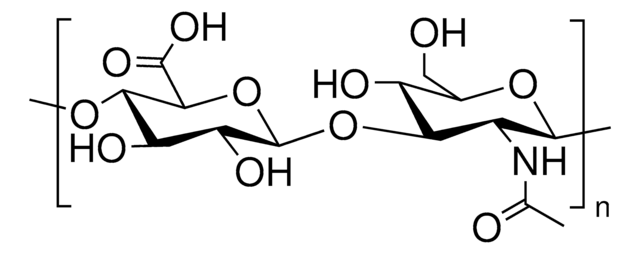This product has not been tested for suitability in cell culture applications. Please see products C9791 and C8919 at the link below to review cell culture tested product options:
https://www.sigmaaldrich.com/substance/bovinecollagentypei123459007345
C9879
Bovine Collagen Type I
from bovine achilles tendon, powder, suitable for substrate for collagenase
Sinonimo/i:
Collagen powder
Scegli un formato
Scegli un formato
About This Item
Prodotti consigliati
Nome del prodotto
Collagen from bovine achilles tendon, powder, suitable for substrate for collagenase
Origine biologica
bovine Achilles tendon
Livello qualitativo
Stato
powder
tecniche
ELISA: suitable
activity assay: suitable
Compatibilità
suitable for substrate for collagenase
N° accesso UniProt
Temperatura di conservazione
2-8°C
Cerchi prodotti simili? Visita Guida al confronto tra prodotti
Descrizione generale
Applicazioni
- the detection of collagenase activity[2][3]
- as a reference sample in the thermal analysis study of human bone using differential scanning calorimetry, thermogravimetry, gas chromatography and Fourier transform infrared spectroscopy[4]
- as a substrate for developing a simple assay for determining collagen degradation in vitro[5]
- a study to examine the binding activity of the integral glycoprotein dipeptidyl peptidase IV to insoluble type I collagen by solid-phase enzyme-linked immunosorbent assay[6]
Azioni biochim/fisiol
Nota sulla preparazione
Ricostituzione
Codice della classe di stoccaggio
11 - Combustible Solids
Classe di pericolosità dell'acqua (WGK)
WGK 1
Punto d’infiammabilità (°F)
Not applicable
Punto d’infiammabilità (°C)
Not applicable
Dispositivi di protezione individuale
Eyeshields, Gloves, type N95 (US)
Scegli una delle versioni più recenti:
Certificati d'analisi (COA)
Non trovi la versione di tuo interesse?
Se hai bisogno di una versione specifica, puoi cercare il certificato tramite il numero di lotto.
Possiedi già questo prodotto?
I documenti relativi ai prodotti acquistati recentemente sono disponibili nell’Archivio dei documenti.
I clienti hanno visto anche
-
Is this suitable for cell culture?
1 risposta-
Utile?
-
-
What is the most suitable solvent for this product?
1 risposta-
As mentioned in the 'DESCRIPTION' section under 'Reconstitution'. This product is an insoluble collagen preparation. It is insoluble in water, aqueous buffers, dilute acid, and organic solvents. For use as a substrate in collagenase assays, this collagen can be prepared as a suspension in 50 mM TES buffer, pH 7.4 with 0.36 mM calcium chloride.
Utile?
-
-
Is it suitable to fabricate a 3D matrix with gelatin and water?
1 risposta-
This collagen product is not tested for 3D gel formation. Residual acids from the extraction and purification process may impact the ability of the material to form a 3D matrix. However, there are several bovine collagen products that are recommended for this application. Please see the links below to review these product options:
Bovine Collagen Type I for 3D
https://www.sigmaaldrich.com/US/en/substance/bovinecollagentypei1234598765
Bovine Collagen Solutions for 3D
https://www.sigmaaldrich.com/US/en/substance/collagensolutionfrombovineskin1234598765Utile?
-
-
Do you have a nominal purity on this product?
1 risposta-
The purity of this product is not tested. It is qualified for use as a substrate for collagenase.
Utile?
-
-
What is the Department of Transportation shipping information for this product?
1 risposta-
Transportation information can be found in Section 14 of the product's (M)SDS.To access the shipping information for this material, use the link on the product detail page for the product.
Utile?
-
-
How should Product No. C9879, Collagen from bovine, be reconstituted?
1 risposta-
This product is an insoluble collagen preparation. It is insoluble in water, aqueous buffers, dilute acid, and organic solvents. A suspension can be prepared in 50 mM TES buffer, pH 7.4 with 0.36 mM calcium chloride, but not a clear solution.
Utile?
-
-
What is the structure of the Collagen from bovine - C9879?
1 risposta-
The amino acid sequence of the primary structure is mainly a repeating motif with glycine in every third position, and a proline or 4-hydroxyproline frequently preceding the glycine residue.
Utile?
-
-
What application can Product No. C9879, Collagen from bovine, be used in?
1 risposta-
This product is suitable for use as a substrate for collagenase. It is not suitable for use as an attachment factor in coating glassware.
Utile?
-
-
What is the molecular weight of product C9879, Collagen from bovine achilles tendon?
1 risposta-
Since product C9879 is an insoluble collagen preparation, it is difficult to make any kind of molecular weight determination. However, based on the reported structure of this collagen, the expected molecular weight would be approximately 300 kDa.
Utile?
-
Filtri attivi
Il team dei nostri ricercatori vanta grande esperienza in tutte le aree della ricerca quali Life Science, scienza dei materiali, sintesi chimica, cromatografia, discipline analitiche, ecc..
Contatta l'Assistenza Tecnica.










